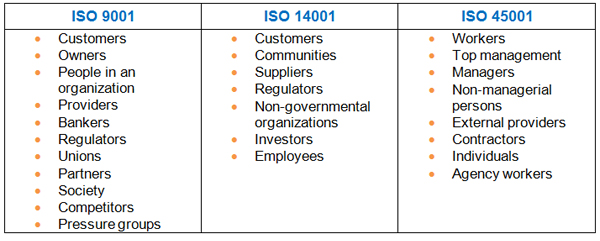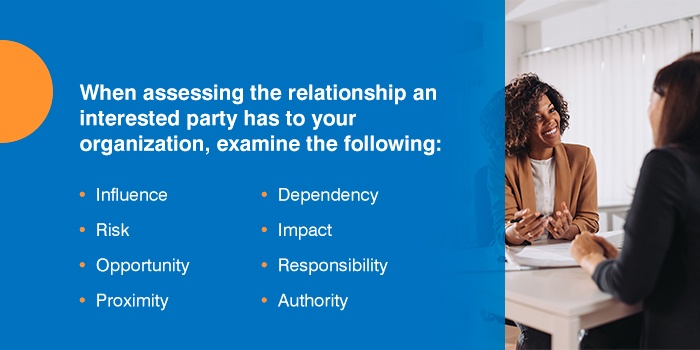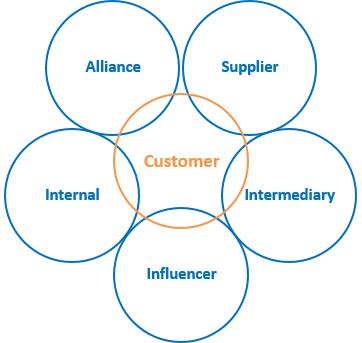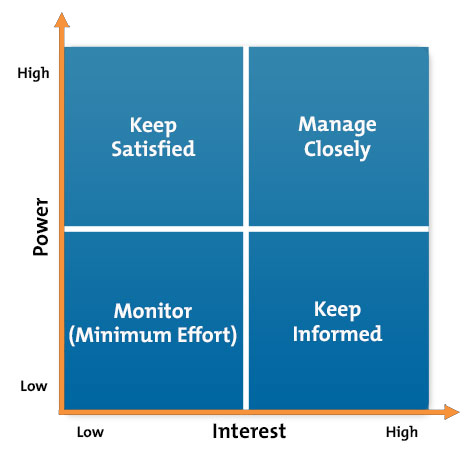Interested Parties: How to define and manage them
*Updated February 2021
The management systems standards ISO 9001, ISO 14001 and ISO 45001 require organizations to understand the expectations and needs of interested parties. The first step toward understanding the needs and expectations of interested parties is understanding who those interested parties are. Once you have an idea of the interested parties relevant to your organization, you can put together a plan to manage them effectively.
This post covers practical steps to identify, understand and prioritize your interested parties.
How to Define Interested Parties
The three management standards define an interested party as a "person or organization that can affect, be affected by or perceive itself to be affected by a decision or activity."
Although the standards have a similar general definition of an interested party, each adds specific guidance notes to refine the definition further:
- ISO 45001 outlines requirements concerning workers who are also interested parties.
- ISO 14001 clarifies that "to perceive itself to be affected” means the perception has been made known to the organization, such as through feedback or comments via the organization's social media channels.
- ISO 9001 defines "interested party" in the context of quality management by clarifying that interested parties are not just customers. Relevant interested parties also include those who can pose "a significant risk to organizational sustainability if their needs and expectations are not met."
What do those definitions mean in practice? Let's take a closer look at specific examples of interested parties.
Examples of Interested Parties
Each management system standard provides generic examples of interested parties:

You might want to review each standard's full definition to get a comprehensive description of each type of interested party. Also, keep in mind that the examples above aren't mutually exclusive. There can be overlap and crossover between management systems based on the relevance of the interested parties. It's also worth noting that the lists above are far from exhaustive. Consider them a starting point.
How to Classify Interested Parties and Their Relationships
A simple list of interested parties isn't sufficient to meet the requirements of the standards, as a simple list doesn't allow you to understand the needs and expectations of the parties.
Instead, you might find it helpful to evaluate the relationship each interested party has with your organization. Since an interested party can affect your organization's ability to provide services or meet legal requirements, you need to understand what each interested party means to you.

When assessing the relationship an interested party has to your organization, examine the following:
- Influence: Can what the interested party does or thinks influence your organization's decision making? Do they influence your industry overall?
- Risk: How much risk does the interested party create for your organization?
- Opportunity: Does the interested party provide or create opportunities for your organization?
- Proximity: How close is the interested party to you? Are they in the same building or town as your organization?
- Dependency: How much do you rely on the interested party? Conversely, how much do they rely on your products or services?
- Impact: What impact does the interested party have on your organization? If they stop associating with you, what will happen?
- Responsibility: How much responsibility do you have to the interested party? If your organization ceases to exist, do they lose money?
- Authority: How much control or say over your organization does the interested party have? Are they responsible for enforcing rules or making sure you follow regulations?
Another way to classify the relationships you have with interested parties is to use the six markets model. Examples of categories in the six markets model are:
- Alliances, such as joint ventures, investors or partnerships
- Customers, such as consumers
- Influencers, such as the media, regulators or reviewers
- Intermediaries, such as retailers
- Internal, such as your employees and managers
- Suppliers, such as your vendors
Understanding the Needs and Expectations of Interested Parties
The importance of stakeholder management to the success of an organization cannot be underestimated – without exaggeration, it is far more than customer focus; it is about actively understanding and managing the positive, negative and changing influences from a range of stakeholders.
Stakeholders are referred to synonymously as Interested Parties by ISO management systems standards. ISO 9000 states their importance clearly:
“Organizations attract, capture and retain the support of the relevant interested parties they depend upon for their success.”
Interested parties are so important that they are considered an integral part of the context of the organization. Interested parties need to be well understood before you define the scope of the management system – in reality, it is more of an iterative process that adapts to changing needs.

The requirement to understand the needs and expectations of interested parties is expressed almost identically in each standard.
The organization shall determine:
- The interested parties that are relevant to the management system
- The requirements [needs and expectations] of these interested parties that are relevant to the management system
How to Manage Interested Parties
The key to managing interested parties is recognizing their relevance to your organization and understanding the significance of their relationship to you.
Identify Relevance, Needs and Expectations
Now you know who your interest parties are, it is time to identify their needs and expectations that are relevant to your management system. The operative word here is relevant.
Depending on the size and complexity of your organization, it is very likely that you or your colleagues will have a good feel for the interested parties you contact regularly. However, it is worth formalizing this knowledge and, where needed, confirming assumptions and closing knowledge gaps with research.
The scale of research again depends on the size and complexity of your organization. For example:
- A two-person gardening firm can make a few calls to suppliers, customers and the local council to get a sense of the relevance of each interested party and the needs and expectations of each.
- A multi-national pharmaceutical company most likely needs to use multiple research methods, such as quantitative and qualitative, primary and secondary, to get a complete view of the needs and expectations of its various stakeholders and interested parties.

Use the Power and Interest Matrix
A useful tool for helping you decide how to manage a particular interested party is the Power/Interest Matrix developed by Johnson and Scholes.
This simple tool relates two important relationship variables:
- How much interest do they have in your decisions and activities? This could be interpreted as the strength of their relevance.
- How much power or influence do they have over your decisions and activities? This could be interpreted as their significance or risk.
Plotting interested parties helps you to prioritize the effort required to meet their needs and expectations:

How to Map Interested Parties
Here are the steps to take to map your interested parties:
- Identify relevant interested parties: Use the examples from the ISO management systems standards, 6 Market Model and other methods to compile a categorized list of your interested parties. Create a table or spreadsheet with columns for Interested Parties, Needs and Expectations, Power/Interest and Objectives.
- Determine their needs and expectations: Use different research methods as necessary to confirm your knowledge of each group or significant stakeholder. Summarize the findings and add them to the relevant column in your table of Interested Parties.
- Rank them in terms of power and interest: Consider their strength of interest and level of influence over your decisions and actions. Plot them in the Power/Interest Matrix to determine their rank. Add the rank to the relevant column in your table of Interested Parties.
- Set objectives and priorities: Define what results are necessary to deliver to those relevant interested parties to reduce the risk that their needs and expectations are not met. Set SMART(Smart, Measurable, Achievable, Relevant, Time-Bound) objectives wherever possible and document them in the table of Interested Parties.
You should end up with something like this example – but create a framework that suits your own needs:

Why Understand the Needs of Interested Parties
Taking the time to understand the needs and expectations of your interested parties is essential to:
- Defining the scope of your management system.
- Ensuring customer satisfaction.
- Meeting compliance obligations.
- Continual improvement of the organization and its management system.
- Meeting the requirements of ISO 9001, ISO 14001 and ISO 45001.
By using the methods described in this article, you can develop your own process or framework for identifying, understanding, monitoring and reviewing interested parties in terms of:
- Level of interest (Relevance)
- Level of influence (Significance)
You should demonstrate a process that connects your interested parties with the scope of your management system and informs the development of policy and objectives.

Get a Quote From an NQA Expert Today
Identifying interested parties and understanding their needs and expectations are just some of the requirements of management systems standards ISO 9001, ISO 14001 and ISO 45001. To learn more about the certification process and the cost of getting certified, contact NQA today to speak with one of our experts. You can also request a Quick Quote or Formal Quote online.

Reviewed by: Judith Hargreaves, NQA Regional Assessor
